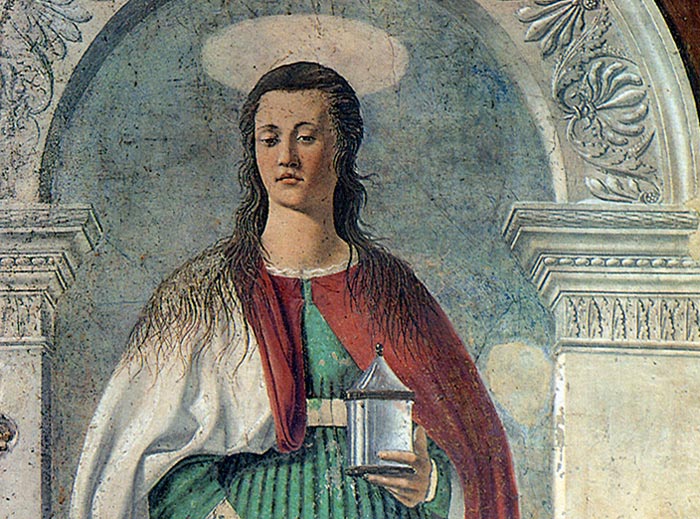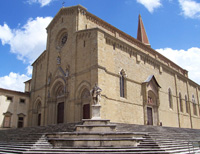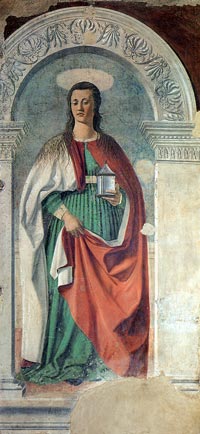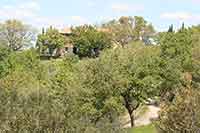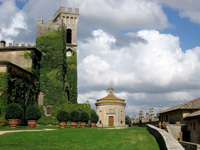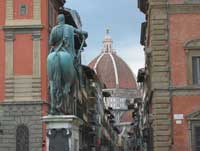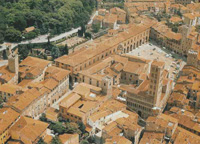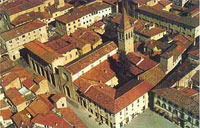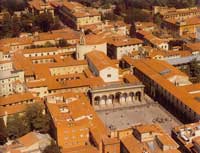The city of Arezzo is perched on a hill above the plain of the Arno river where the rugged Casentino mountains meet the rich foothills of the Valdichiana. Arezzo is the city where Piero della Francesca painted the Legend of the True Cross in the church of San Francesco, universally considered his master-work by critics of all epochs. In 1452 the wealthy merchant family Bacci, patrons of the principal chapel in the church of San Francesco, summoned Piero to Arezzo to finish the fresco cycle started by Bicci di Lorenzo, and interrupted due to his death that year. The decision to choose Piero della Francesca to substitute the old master might seem hard to explain at first, considering the differences between the two artists: the lattet bound to the late Gothic traditions of Tuscany as strongly as the substitute was an innovator. Actually, the decision to decorate the chapel had been made many years before. It is possible that Bicci di Lorenzo had been designated during the 1420's, when the friars believed that work would have been started soon. No doubt the artist intended to honor his commitment, even though he was over seventy years of age in 1447 when he started the fresco cycle. The assignment of the commission to a painter like Ricci, who had a large workshop in Florence that was perfectly faithful to antique traditions and had failed to absorb anything of the extraordinary novelty that had made Florence the center of artistic innovation in Italy and Europe, is an indication of the somewhat old-fashioned and provincial taste of Arezzo, overshadowed by Florence nearby.
Actually, the origins of Arezzo are quite ancient and go back to the Etruscans, when Arretium was an important center of artistic production of artifacts such as the famous bronze Chimera, exhibited at the Archeological Museum of Florence and some terracotta knights of the fifth century BC, exhibited at the Archeological Museum of Arezzo. When it came under Roman influence, Arezzo became an important center on the Via Cassia, situated as it is along the Rome-Florence-Romagna axis, and expanded prosperously during the Hellenistic era. About the middle of the first century BC, a pottery industry was thriving that produced vases with relief decorations, known by the name of the city or as "coral" vases due to their color. However this industry was already a thing of the past by the end of the first century AD, and the city entered a phase of decline that lasted until the High Middle Ages, when disputes about the control of churches and chapels led to some conflicts with Siena. Signs of recovery began to appear from the eleventh century, during the era of the city-states; during the thirteenth and fourteenth centuries Arezzo, which belonged to the Ghibelline faction, intensified its battles against Siena and Florence. After the famous defeat at the battle of Campaldino in 1289, against Florence, the city again slipped into a state of decline, except for the period 1312-1328 when bishop Guido Tarlati seemed to have raised their expectations.
Arezzo was sold to Florence in 1137 and again in 1384, when it lost its independence and tied its destiny to the Florentine state. The presence of "foreigners" was also significant in the art of Arrezzo, especially in painting. After the debut of Margaritone, most of the leading artists were from Florence (Cimabue, some followers of Giotto and other minor artists) and from Siena, including Pietro Lorenzetti. During the second half of the fourteenth century Spinello Aretino distinguished himself as a very talented artist, whose work was continued by his son Parri, in the same style which still reflected its Gothic origins. The arrival of Piero della Francesca, probably at the instigation of Giovanni Bacci, who was a scholarly humanist, well integrated into the Roman Curia, thus introduced a real charge of artistic innovation.
Piero arrived in Arezzo in 1452, and interrupted his stay during the years 1458-59, when he went to Rome at the invitation of pope Pius II Piccolomini. For some scholars, the latter dates mark the completion of the frescos in Arezzo; according to others this was just one of Piero's many interruptions, and they believe that he continued to work on the frescos after his return. After the success and admiration that Piero inspired with his master-work about the Legend of the True Cross, he received many commissions, including the Mary Magdalene for the cathedral of Arezzo: today we don't know if it was a simple devotional image as it appears to us or if it was part of a larger composition that has since disappeared. Another work by Piero is well-documented, although it has since disappeared: the standard with the Annunciation, commissioned in 1466 by the religious company dedicated to the Virgin of the Annunciation. Arezzo was full of Piero's imitators, mostly mediocre, with the exception of Lorentino d'Andrea, his assistant for the cycle in San Francesco.
The main episodes depicted are:
1 Death of Adam; Seth meeting the Archangel Michael
Adam (on the right), on his death-bed, sends his son, Seth to the Archangel Michael, keeper of the Gates of Paradise, to get some oil of mercy; the Archangel (seen in the background) refuses the oil but gives him a seedling from the tree of Original Sin to be placed in Adams mouth when he is buried (on the left); from this shoot and from Adam's body, which had been the cause of man's downfall, a healthy tree would grow (centre) the wood of which would be used for Christ's Cross and thus for the resurrection of man.
2 The Adoration of the Holy Wood; the Queen of Sheba kneels in front of the wood from which the cross will be made and meets King Solomon
Centuries later, Solomon, King of Israel, has the tree cut down but the wood could not be worked in any way so it was thrown across the river Silo to make a little bridge. The Queen of Sheba, when visiting the king, fell to her knees (centre) in front of the wood, having had a premonition of how it would be used: the crucifixion of the Messiah. During her meeting with King Solomon (on the right) the Queen revealed her premonition.
3 The burial of the Sacred Wood
On King Solomon's orders, the wood, which would be the cause of the scattering of the Jews, was removed and thrown into the depths of the earth. (note the similarity in iconography to that of the Road to Calvary).
4 The Annunciation to Mary
5 The Vision of Constantine
On the eve of his battle against Maxentius in 312 AD, Constantine the Great was told in a dream that he would have victory in the name of the Cross.
6 The Victory of Constantine (Constantine's victory over Maxentius at the battle of Milvian Bridge)
7 The Torture of Judas the Jew
All trace of Christ's Cross had, in the meantime, been lost, so Constan- tine's mother, Saint Helena, went to Jerusalem to find it and to build the Basilica of the Holy Cross. There she met a Jew who knew where the Cross was buried but did not want to tell her. However, after having been put into the bottom of a dry well for six days and nights the man agreed to reveal where the Cross was.
8 The Discovery and Proof of the True Cross
The three crosses were then dug up in Jerusalem (seen in the back- ground on the left; in actual fact Arezzo with the Cathedral of San Donato and San Pietro clearly visible). To distinguish the cross of Christ from those of the two thieves, they were taken in turn to the body of a dead youth who came backto life (on the right) when touched by the True Cross. Saint Helena knelt in front ofThe True Cross in adoration (as had the Queen of Sheba in the corresponding painting on the right wall).
9 The Battle of Heraclius and Chosroes
In 615 AD the Persian king Chosroes had profaned the Cross by placing it next to his own throne (on right). The Eastern Emperor Heraclius faced him in battle (on left) and won, but when Chosroes refused to con- vert to Christianity he was condemned to decapitation (the detail shown again on the right).
10 The Exaltation of the Cross
Heraclius carried the Cross back to Jerusalem: in great humility, with bare feet and just a simple robe, he offered it in adoration to a group of nobles of the Sacred City.
11 The Prophet Isaiah
12 The Prophet Jeremiah
13 An angel
|
|
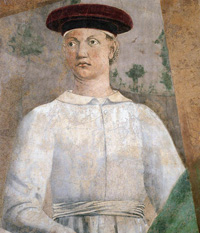
Piero della Francesca painted a self portrait in The Discovery and Proof of the True Cross
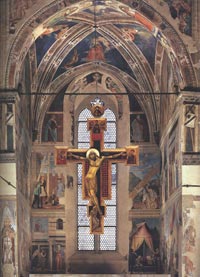
Legend of the True Cross, Bacci Chapel, Basilica of San Francesco
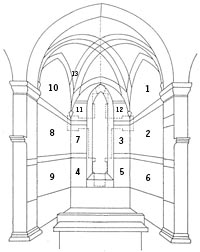
Narrative sequence
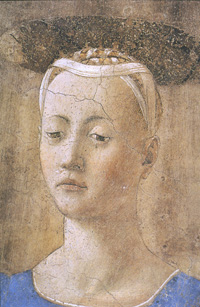
Piero della Francesca, Madonna del parto (dettaglio) |
![]()

